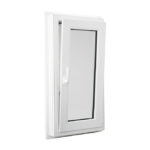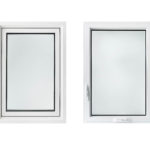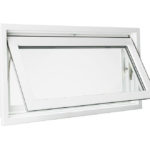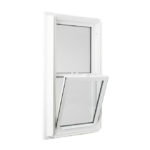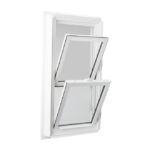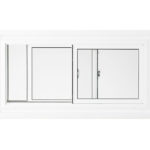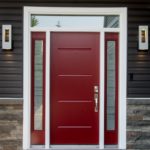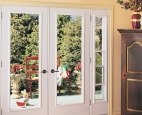Keep your new windows and entrance system looking great and working great for many years. All windows and doors must be maintained properly to ensure trouble-free use. All moving parts should be lubricated at least once per year and dust, dirt and lint buildup should be removed with a clean cloth. Your warranty may be void if proper product care and maintenance are not followed.
SEAL MAINTENANCE
Visible exterior and interior sealed joints on windows and doors should be checked yearly. Inspect the caulking, ensuring that all caulking is still in contact with both adjoining surfaces, has not shrunk or cracked or fallen out. If so, clean off the old caulking as well as possible and apply a good quality silicone based, outdoor grade sealant (i.e. caulking).
PREVENTING WINDOW CONDENSATION
Window condensation is a frustration for homeowners, especially if their windows are new. Immediate thoughts are of mold, water damage, peeling paint and reduced energy savings. To help our customers prevent window condensation, we need to understand why condensation occurs and how to prevent it.
Humidity and Condensation
Condensation occurs when there is a reduction in the rate of air exchange (i.e. closing windows in winter) and there is excess humidity in the home. Humidity is the amount of moisture or water vapour in the air. People and pets produce moisture when they breathe or perspire. Even indoor plants produce moisture. We add water vapour to indoor air through everyday household activities: cooking, showering, bathing and doing laundry. Every time you run the dishwasher, you add 5 lbs of moisture to your home! We need humidity for our comfort and health. But too much or too little humidity can produce a host of difficulties in homes. Some of the problems are just nuisances like condensation on windows and musty smells, others can be more serious such as wet stains on walls and ceilings, moldy bathrooms and allergic reactions. Humidity hassles often occur during the colder months when windows are closed, and indoor air circulation is reduced.
Humidity Levels
Experts have developed rules of thumb to help homeowners make decisions regarding humidity levels in their homes. The limits should be used as guides only. Acceptable or comfortable humidity levels will vary from season to season, from house to house, and even between rooms in the same house. To measure the indoor humidity in a home, you can purchase a small inexpensive tool called a hygrometer that measures relative humidity (RH). The recommended indoor relative RH when the outdoor temperature is above 10° C is 30 to 50 percent. When the outdoor temperature is below 10° C, the recommended RH is 30 percent.
Measuring A Home’s Humidity Level
You can determine how much moisture is in your home with an inexpensive Hygrometer that can be purchased from your local hardware store. Place the Hygrometer in your home for a few days and record the readings each day. Compare your data to the chart below. As outside temperatures drop, the indoor relative humidity level of your home should decrease. For homes with windows equipped with insulating glass, the University of Minnesota Agriculture Extension Service reports that the following humidity levels can be maintained in the home without causing window condensation. If your home’s relative humidity is higher than this chart, please consult Excess Moisture: Causes and Cures for tips on identifying and eliminating sources of excess moisture in your home. Outside Air Temperature with ideal inside relative humidity for 70° F (21° C) indoor air temperature:
- -20° F (-29° C) outside should be 15% to 20% humidity inside
- -10° F (-23° C) outside should be 20% to 25% humidity inside
- 0° F (-18° C) outside should be 25% to 30% humidity inside
- +10° F (-12° C) outside should be 30% to 35% humidity inside
- +20° F (-7° C) outside should be 35% to 40% humidity inside
How Our Windows Help
We use warm edge technology on all our windows and doors, creating an insulated air space between the glass units. Warm edge spacers also keep the edges of your window glass warmer, reducing condensation. Double and triple-glazed windows ensure the humidity inside the room can be higher than a room with ordinary single glazing before condensation occurs. Because the units are sealed at the factory, condensation between the panes of glass does not occur.
The first step of preventing condensation is controlling humidity. Begin with installing new energy-efficient windows with a high-performance rating. High-efficiency windows may not solve all condensation concerns, but properly installed, sealed and insulated windows are the first step towards eliminating humidity issues. Although excessive humidity shows up as condensation on the cold surface of a window, the window is probably not the source of the condensation problems.
Further reducing humidity in homes is not difficult. Begin by remembering to open or close doors and windows on a periodic basis to exchange the air in the house. Exhaust fans may have to be installed in bathrooms and kitchens and seal up the house with weatherstripping and caulking. Humidifiers, both stand-alone or attached to furnaces, can be sources of excessive moisture and mold, ensure they are not overused.
Tips to Prevent Window Condensation
- Install an air exchange unit or a humidity control device to maintain the proper level of humidity
- Insulate water pipe
- Ensure hot air from registers does not flow directly on to the interior surface of the glass
- Turn furnaces with humidifiers off until condensation reduces
- Ensure the exhaust from the clothes dryer is vented outside
- Cover crawl spaces with 0.15 mm (6 mil) polyethylene
- Ensure gutters drain water away from the house
- Avoid drying firewood in the house
- Waterproof damp basement walls and floors
- Use exhaust fans while cooking
- Open a window when doing laundry
- Close the bathroom door and open a window after baths and showers
- Ventilate the home at least once a day
Exterior Condensation*
Condensation on the outdoor surface of an insulating unit is not an indication that the glass or insulating unit is defective. Under the right set of atmospheric conditions, it is possible to get condensation on the exterior glass surface of an insulating glass unit. Specifically, the following conditions:
- glass temperature below dew point temperature
- clear night sky
- still air
- high relative humidity
- well insulated glazings
Exposed to these conditions, the exterior surface of the glass can radiate heat away to the night sky such that the glass temperature falls below the dew point of the ambient air. When this occurs, moisture from the air condenses on the glass surface. Only when the glass temperature rises above the dew point will the condensation evaporate back into the air. Dew formation on grass, car hoods and roofs, and building roofs and walls is common and accepted as a fact of nature.
The presence of moisture indicates that a specific set of atmospheric conditions exist and that the insulating glass is indeed doing its job – that of insulating the building from the environment. In this case, that insulation capability is what retards the flow of building heat through the glass and prevents warming of the exterior above the dew point.
If exterior condensation occurs on insulating glass, there is little or nothing that can be done to prevent its reoccurrence. Draperies should be open to allow as much heat transfer through the glass as possible. Trees or buildings can block the radiation view to the sky. Shrubbery immediately adjacent to the glass can increase the local humidity and may need to be moved. The exterior surface of the glass will warm and the condensation will evaporate when either the heat loss to the sky is blocked (i.e. clouds), the wind picks up, or sunlight is absorbed on the glass surface.
*Source: Cardinal Glass
Guides: CMHC Guide to Moisture And Air; Additional Interior, Exterior Condensation & Air Convection Information
STAIN REMOVAL
Stain Type: Heavy grease, caulking compound, wax, crayon, asphalt, and tars
Cleaning Agents: Mineral spirits, auto tar remover, all-purpose liquid cleaners or rubbing alcohol.
Preparation: Remove excess with plastic or wood scraper.
Cleaning Procedures: Use a soft cloth to apply and avoid polishing the stained area by using too much pressure. After removing a stain, rinse the area with water.
Stain Type: Inks, nail polish, paint, gum, and lipstick
Cleaning Agents: Petroleum jelly, denatured alcohol or hairspray.Preparation: Remove excess with plastic or wood scraper. Chill gum to remove excess.
Cleaning Procedures: Use a soft cloth to apply cleaning fluid and avoid polishing the stained area by using too much pressure. After removing a stain, rinse the area with water.
Wood stain and Permafinish™ components can be wiped with a cloth dampened with a mixture of 1 quart of warm water and 3 or 4 drops of dishwashing liquid, then rinse and buff dry.
Permafinish™ & Factory Stained Fiberglass Slabs
At Kohltech we pride ourselves on producing top quality door systems that provide beauty, performance and exceed your expectations. Our in house stain process is applied by hand with attention to detail by our trained artisans who have many years of experience.
Please keep in mind the following facts when applying stain to your door system and we encourage you to use the Kohltech system to ensure your door performs for a long time:
- At Kohltech we use a specially formulated stain on our fiberglass slabs to ensure a proper bond. When necessary a fiberglass primer is used to help match to other components (trim rings, frame, etc). This promotes a more uniform process across all the various substrates.
- We thoroughly clean all materials before the staining process.
- We stain in a humidity-controlled, clean environment. This is important to ensure a nice even coating and better cure process.
- We stain before assembly to treat all grooves, contours, and voids that may not be accessible after assembly.
- We have a curing area with infrared lights to allow for consistent curing time.
- All stained systems have a clear-coat polyurethane applied as the final process. This is very important to ensure long life and durability of the finish.
- Coating textured doors are more of an art than a science and require unique skill to properly stain a fiberglass door. Kohltech’s process is done by specialists, with years of experience, who are trained in the art of fiberglass staining.
Please Note: If you choose to paint your own system, exterior latex can be applied. Painting your own door or window results in all warranty being voided.
Kohltech offers a 10-year warranty against fading, peeling, wearing, cracking and blistering on all factory applied coated door systems.
HARDWARE CARE AND MAINTENANCE
Window and door hardware is expected to give trouble-free operation throughout the life of the product. All of the hardware is protected or enhanced by special coatings and lubricants. These protective coatings and lubricants can be damaged or removed by common household products.
Windows and doors are mechanical systems that need to be maintained. Moving parts need to be inspected for wear and cleaned and lubricated
on an annual basis.
Cleaning
Due to the wide range of environments our hardware is used in, some cleaning may be required. Windblown dust and dirt can cause the windows to be more difficult to operate, as well as cause the hardware to wear or corrode.
We recommend the window hardware be inspected once a year (more if necessary) and cleared of dirt and grime build up. Particular attention should be given to cleaning dirt from slides in hinges.
Clean water should be used when possible to flush the hardware clean. A mild dish soap and water mixture can be used to loosen stubborn dirt. Always rinse the hardware with clean water and allow the hardware to dry completely before lubricating.
DO NOT use the following cleaners
- vinegar based cleaners
- citrus based cleaners (lemon, etc.)
- industrial strength cleaners
- abrasive cleaners
These types of cleaners will not only remove the lubricants from the hardware they can also remove the corrosion resistant coatings.
Warning: glass cleaners and brick/siding washes, with the above ingredients, must not come in contact with the hardware for the reasons listed above.
Lubrication
After the hardware is clean and dried it must be lubricated to restore the smooth operation, and in some cases corrosion resistance. Use a silicone lubricant spray to lubricate all moving parts. Avoid using a grease-based lubricant as these lubricants can pick up dust and dirt over time and negatively impact the smooth operation of the window. Care must be used when applying any lubricant to avoid staining and/or damage to window parts. Since lubricants wear away over time, periodic checks should be done to ensure the hardware is functioning smoothly.
ESSENTIAL INFORMATION
Help Kohltech provide service on your newly purchased windows and doors, please record the following information:
- Original Customer Name
- Original Customer Address
- Order Number
- Delivery Date
- Authorized Dealer
